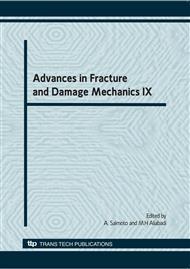[1]
A. Fatemi, L. Yang: Cumulative fatigue damage and life prediction theories, a survey of the state of the art for homogeneous materials. Int. J. Fatigue, Vol. 20 (1998), p.9.
DOI: 10.1016/s0142-1123(97)00081-9
Google Scholar
[2]
F.A. Kandil, M.W. Brown, and K.J. Miller: Biaxial low-cycle fatigue fracture of 316 stainless steel at elevated temperature, Book 280, The Metal Society, London, (1982), p.203.
Google Scholar
[3]
C.H. Wang and M.W. Brown: A path-independent parameter for fatigue under proportional and non-proportional loading. Fatigue Fract. Engng. Mater. Struct., Vol. 16(1993), p.1285.
DOI: 10.1111/j.1460-2695.1993.tb00739.x
Google Scholar
[4]
K.N. Smith, P. Watson and T.H. Topper: A stress-strain function for the fatigue of metals, Journal of Materials, Vol. 5(1970), p.767.
Google Scholar
[5]
A. Fatemi and D.F. Socie: A critical plane approach to multiaxial fatigue damage including out-of-plane loading. Fatigue Fract. Engng. Mater. Struct, Vol. 14(1988), p.149.
DOI: 10.1111/j.1460-2695.1988.tb01169.x
Google Scholar
[6]
J.A. Bannantine and D.F. Socie: A variable amplitude multiaxial fatigue life prediction method, In: Kussmaul K, McDiarmid D. Socie D, editors. ESIS10. London: Mechanical Engineering Publications, (1991), p.35.
Google Scholar
[7]
C.H. Wang and M.W. Brown: Life prediction techniques for variable amplitude multiaxial fatigue-Part 1: Theories. Transactions ASME, J. Engng. Mat. Tech., Vol. 18(1996), p.367.
DOI: 10.1115/1.2806821
Google Scholar
[8]
C. H Wang. and M.W. Brown: Life prediction techniques for variable amplitude multiaxial fatigue-Part 2: Comparison with experimental results. J. Engng. Mat. Tech., Vol. 18(1996), p.371.
DOI: 10.1115/1.2806822
Google Scholar
[9]
J.D. Morrow: The effect of selected sub-cycle sequences in fatigue loading histories, In Random Fatigue Life Predictions, ASME Publication PVP 72, (1986), p.43.
Google Scholar
[10]
K.S. Kim, B.L. Lee, and J.C. Park: Biaxial fatigue of stainless steel 304 under irregular loading. fatigue and fracture mechanics: ASTM STP 1389, Halford G.R. and Gallagher, Eds., American Society for Testing and Materials, West Conshohocken, PA (2000).
DOI: 10.1520/stp14795s
Google Scholar
[11]
X. Chen, D. Jin: Kwang Soo Kim, A weight function-critical plane approach for low-cycle fatigue under variable amplitude multiaxial loading, Fatigue Fract. Engng. Mater. Struct., Vol. 29 (2006), p.331.
DOI: 10.1111/j.1460-2695.2006.01003.x
Google Scholar


